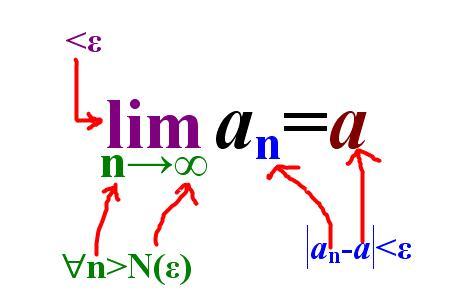naive blog
从思想到定义——再探极限
回顾
上篇文章,我们通过从反面去思考的方式,探索出了极限的定义,请允许我再抄录于此:
数列极限:
对于数列 $\displaystyle \{a_n \}$ 和常数 $\displaystyle a$ ,若 $\displaystyle \forall \epsilon >0 ,\exists N(\epsilon) \in R,s.t.\forall n>N(\epsilon),|a_n-a|<\epsilon$ ,其中 $\displaystyle N(\epsilon)$ 为关于 $\displaystyle \epsilon$ 的函数,则称数列 $\displaystyle \{a_n\}$ 收敛于 $\displaystyle a$ ,记作 $\displaystyle \lim_{n \to + \infty}a_n=a$
函数极限:
对于函数 $\displaystyle y=f(x)$ 和常数 $\displaystyle x_0$ 、 $\displaystyle a$ ,若 $\displaystyle \forall \epsilon >0,\exists \delta (\epsilon)\in R^+,s.t.\forall|x-x_0|<\delta(\epsilon)\wedge x \neq x_0,|f(x)-a|<\epsilon$ ,其中 $\displaystyle \delta(\epsilon)$ 为关于 $\displaystyle \epsilon$ 的函数,则称 $\displaystyle x \to x_0$ 时, $\displaystyle f(x) \to a$ ,记作 $\displaystyle \lim_{x \to x_0}f(x)=a$
数列极限

数列,由两个对象组成:一个是角标n,一个是数列值 $\displaystyle a_n$ 。极限这种高端的手段,当然涉及了数列的全部这两个对象。
我们不妨来分析一下定义: $\displaystyle \epsilon$ ,用于 $\displaystyle a_n$ 和a之间比大小,所以控制的是数列值向极限值接近的程度。而 $\displaystyle N(\epsilon)$ ,用于和n比大小,所以控制的是角标向无穷大接近的程度。一句话概括极限的定义:咱想多接近极限值,就可以多接近极限值。
这里需要注意的有几点:
第一,极限定义中数列值与极限值大小比较的 $\displaystyle \epsilon$ 可被 $\displaystyle f(\epsilon)$ 替换,其中 $\displaystyle f(\epsilon)$ 满足: $\displaystyle \forall \epsilon>0,f(\epsilon)>0$ 且 $\displaystyle \lim_{\epsilon \to 0}f(\epsilon)=0$ 。
用一个简单的例子说明这一点:
下面证明如果一个数列存在极限,则极限唯一。即:
若 $\displaystyle \lim_{n \to +\infty}a_n=a$ , $\displaystyle \lim_{n \to +\infty}a_n=b$ ,则 $\displaystyle a=b$
证明:由题意,可得: $\displaystyle \forall\epsilon>0,\exists N_1(\epsilon) \in R,s.t.\forall n>N_1(\epsilon),|a_n-a|<\frac\epsilon 2$ $\displaystyle \forall \epsilon>0,\exists N_2(\epsilon) \in R,s.t.\forall n>N_2(\epsilon),|a_n-b|<\frac\epsilon 2$ 取 $\displaystyle N(\epsilon)=\max\{N_1(\epsilon),N_2(\epsilon)\}$ 则 $\displaystyle \forall \epsilon>0$ ,当 $\displaystyle n>N(\epsilon)$ 时, $\displaystyle |a-b|\leq|a_n-a|+|a_n-b|<\epsilon$ 。故 $\displaystyle |a-b|=0$ ,即 $\displaystyle a=b$
这点其实挺好理解的。也许看到我上面用 $\displaystyle f(\epsilon)$ 这种方式写比较费解,看到例子里的 $\displaystyle \frac\epsilon2$ 也许就比较清晰了吧。
其实这样写,是为了最终结果那一步比较好看,没多大实际用处。
第二, $\displaystyle N(\epsilon)$ 为关于 $\displaystyle \epsilon$ 的函数。你不能说,对于找不到一个固定的常数N,使这个命题为真,所以极限不存在。举个通俗的例子来说:《三体》中的大低谷时代,资源越来越紧缩,但对于每一个时间点对应的资源紧缩程度来说,人类总有对应的方法存活。资源的紧缩程度,就是 $\displaystyle \epsilon$ ,人类对应的方法,就是 $\displaystyle N(\epsilon)$ 。事实上,并不存在某个固定的方法,使得对于任意资源紧缩程度,人类都可以生存。生存的唯一方式,就是根据环境条件而改变策略。
第三, $\displaystyle \forall n> N(\epsilon)$ 一句。这个有些人会一扫而过,事实上也有需要注意的地方。用比较费解的方法解读这句话,意思是:角标以 $\displaystyle f(n)=n$ 的正比例关系趋于无穷。一般地,可以有 $\displaystyle \lim_{b_n \to +\infty}a_n$ 的形式。定义即为, $\displaystyle \forall \epsilon>0,\exists N(\epsilon)\in R,s.t.\forall b_n>N(\epsilon),|a_n-a|<\epsilon$ 。事实上, $\displaystyle \lim_{\frac1n \to +\infty}a_n$ 与 $\displaystyle \lim_{n^2 \to +\infty}a_n$ 不一定相同,所以不同的 $\displaystyle \{b_n\}$ 产生的结果可能是不同的。但是,有一个定理可以阐述如下:
若数列 $\displaystyle \{b_n\}$ 满足 $\displaystyle \lim_{n \to +\infty}b_n=+\infty$ (关于极限为无穷的定义请看后文),且 $\displaystyle \lim_{b_n \to +\infty}a_n=a$ ,则 $\displaystyle \lim_{n \to +\infty}a_n=a$ 。
证明:由题意: $\displaystyle \forall M>0,\exists N_1(M)\in R,s.t.\forall n>N_1(M),b_n>M$ $\displaystyle \forall \epsilon>0,\exists N_2(\epsilon)\in R,s.t.\forall b_n>N_2(\epsilon),|a_n-a|<\epsilon$ 取 $\displaystyle N(\epsilon)=N_1(N_2(\epsilon))$ ,则 $\displaystyle \forall \epsilon>0,\exists N(\epsilon)\in R,s.t.\forall n>N(\epsilon),|a_n-a|<\epsilon$
第四, $\displaystyle |a_n-a|<\epsilon$ 一句。切记不可随意替换角标n。事实上, $\displaystyle \lim_{n \to +\infty}a_{t_n}=a$ 的定义即为 $\displaystyle \forall \epsilon>0,\exists N(\epsilon)\in R,s.t.\forall n>N(\epsilon),|a_{t_n}-a|<\epsilon$ .这替换了角标之后,实际上是取了一个 子列 (subsequence),子列极限与数列极限不一定相等。比如, $\displaystyle a_n=(-1)^n$ ,那么显而易见 $\displaystyle \lim_{n \to +\infty}a_n$ 不存在,而 $\displaystyle \lim_{n \to + \infty}a_{2n}=1$ .事实上,有这么一个定理可以阐释子列极限与数列极限的关系:
若 $\displaystyle \lim_{n \to +\infty}a_n=a$ ,则对于任意递增正整数列 $\displaystyle t_n$ , $\displaystyle \lim_{n \to +\infty}a_{t_n}=a$
这里不再证明。
函数极限
和数列极限类似,函数极限也有一些注意点。和上面重复的我就不再赘述。
这里要注意的点有:
第一, $\displaystyle \forall |x-x_0|<\delta (\epsilon) \wedge x \neq x_0$ 一句。这里有一个重点,即为这里的对于任意x,x的取值范围是什么?从高数的定义上来说,x的取值范围是 $\displaystyle \{x||x-x_0|<\delta (\epsilon),x\neq x_0,x \in R\}$ .
而数学分析的定义则不然。
如果E是函数 $\displaystyle y=f(x)$ 的定义域,而 $\displaystyle E^\prime$ 是E中所有极限点构成的集合。所谓极限点,定义如下:若p为E的极限点,则p的任意邻域都包含E中一个不等于p的元素q。如果理解不了,那就认为,对我们学习的一般的函数而言, $\displaystyle E^\prime$ 就是它的定义域E。
那么从数学分析的定义上来说,x的取值范围是 $\displaystyle \{x||x-x_0|<\delta (\epsilon),x\neq x_0,x \in E^\prime \}$
两者有何区别呢?我们来看一道特别特别特别著名的考研题:
求 $\displaystyle \lim_{x \to 0}\frac{\sin (x \sin \frac1x)}{x \sin \frac1x}$
具体解法我们就略过了,结果最终算出来是1.
但这个答案其实是有争议的。
按照高数的定义,我们记 $\displaystyle f(x)=\frac{\sin (x \sin \frac1x)}{x \sin \frac1x}$ ,那么:
$\displaystyle \forall \epsilon >0,\exists \delta (\epsilon)\in R^+,s.t.\forall|x|<\delta(\epsilon)\wedge x \neq 0,|f(x)-1|<\epsilon$
根据我们刚刚所讲,这里x的取值应为 $\displaystyle D=\{x||x|<\delta (\epsilon),x\neq0,x \in R\}$
而对于任意 $\displaystyle \delta (\epsilon)>0$ 来说,只要 $\displaystyle k>\frac{1}{\pi \delta (\epsilon)}\wedge k \in Z$ ,那么 $\displaystyle x_k =\frac{1}{k \pi}$ 就一定在D内。
但是, $\displaystyle f(x_k)$ 不存在,就满足不了 $\displaystyle |f(x_k)-1|<\epsilon$ 这一条件了。
然而,用数学分析的定义,就可以很好地规避这一问题。
第二, $\displaystyle x \neq x_0$ 和 $\displaystyle |f(x)-a|<\epsilon$ 两句:都暗示我们,函数在某个点处的极限值,与该点处的函数值无关。比如说,对分段函数 $\displaystyle f(x)=1(x \neq 0)$ , $\displaystyle f(x)=0(x=0)$ 而言, $\displaystyle \lim_{x \to 0}f(x)=1$ .再如,即使该点无定义,亦可有极限值,比如说 $\displaystyle \lim_{x \to 0}\frac{\sin x}{x}=1$
第三,切忌随意变量替换。已知, $\displaystyle \lim_{x \to x_0}u(x)=u$ , $\displaystyle \lim_{x \to u}f(x)=a$ ,然而, $\displaystyle \lim_{x \to x_0}f(u(x))$ 未必等于a。
举例为:
$\displaystyle u(x)=0$ ,分段函数 $\displaystyle f(x)=1(x \neq 0)$ , $\displaystyle f(x)=0(x=0)$ 那么 $\displaystyle \lim_{x \to 0}f(u(x))=0$ $\displaystyle \lim_{x \to x_0}u(x)=0$ , $\displaystyle \lim_{x \to 0}f(x)=1$
摘自《实分析中的反例》
同样来自《实分析中的反例》,我们有如下定理:
如果函数 $\displaystyle f(x)$ 和 $\displaystyle u(x)$ 满足如下条件之一:
1. $\displaystyle f(x)$ 在 $\displaystyle x=u$ 处连续, $\displaystyle \lim_{x \to x_0}u(x)=u$
2. $\displaystyle \lim_{x \to u}f(x)=a$ , $\displaystyle \lim_{x \to x_0}u(x)=u$ ,且在集合 $\displaystyle \{x|x \in N_r(x_0) \wedge x \neq x_0\}$ 中有 $\displaystyle u(x)\neq x_0$
则: $\displaystyle \lim_{x \to x_0}f(u(x))=\lim_{x \to u}f(x)$
(关于连续的概念会在之后的文章里提到。)
补充定义——无穷大
对于数列 $\displaystyle \{a_n\}$ ,
若 $\displaystyle \forall M,\exists N(M)\in R,s.t.\forall n>N(M),a_n>M$ ,则记为 $\displaystyle \lim_{n \to +\infty}a_n=+\infty$
若 $\displaystyle \forall M,\exists N(M)\in R,s.t.\forall n>N(M),a_n<M$ ,则记为 $\displaystyle \lim_{n \to +\infty}a_n=-\infty$
其中 $\displaystyle N(M)$ 为关于M的函数。
函数的定义类似,这里不再赘述。
以上定义即为极限为无穷的情形。类似于上篇文章我们从反面考虑的方式,我们能很容易地得出这种定义:要多大就有多大;要多小就有多小。
这里值得注意的是,“极限存在”与“收敛”这两个词汇。一般来说,“收敛”这个词汇,只用于一个数列存在极限值且极限值为有限常数。“极限存在”在不同书目的定义中有些不同。收敛的数列必然极限存在。但有的书目为了明确,往往还会说“该数列极限存在且不为无穷大”。
最后补充一点,极限可以为有限常数,可以为无穷大,也可以不存在极限。比如说 $\displaystyle a_n=(-1)^n$ ,就不存在极限。